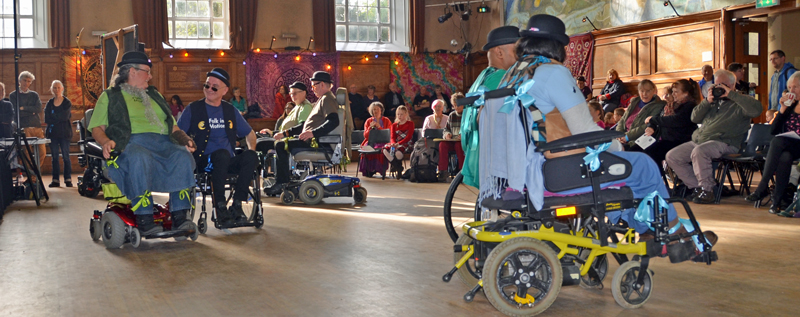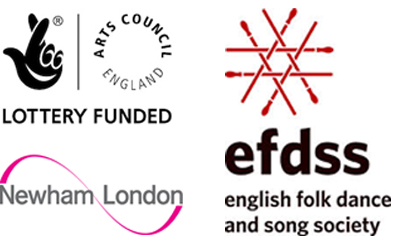How to set up a Wolk Team You can download this information in Word and PDF formats
All you need in addition to our free resources to run a Wolk dancing session is sufficient space to dance on a hard surface (indoor or outdoor); a music source (a smartphone and a bluetooth speaker will do, but using a small PA or karaoke machine with a microphone ensures that everyone can hear); and a set of ribbons (try light/dark blue, light/dark green, pink/purple, red/orange …) It will also be helpful to have access to a pump for pneumatic tyres, electrical and gaffer tape and cable ties for short-term repairs, and WD40 for sticky wheels. Remember to check out our full safety guide before you start. Start each session with a short warm-up (a sample is included). This will help to avoid injuries as well as ensuring that everyone gets the maximum benefit from the session. Encourage onlookers to join in too (but staying seated unless they need to stand to support a participant). It is helpful to have a separate caller when you are learning the dances. If necessary, dancers can call the dances that they are responsible for leading (see Wolk Rules! for details), but remember that you will then need a wireless clip-on or headset microphone for connection to a PA or portable speaker so that everyone can hear clearly. Teams can invent their own kit, but a good staple is a T-shirt in the relevant colour, perhaps with the team logo on it (you can easily buy iron-on transfers for computer printers). Team members should be encouraged to develop their own accessories in ‘their’ colour, rather than trying to look identical, but aim for a team 'look'. Folk in Motion buys plain t-shirts and gets a local printer to over-print them with our logo. For performances, we like to incorporate costume elements from English country dance, Morris and traditions dating from the industrial revolution, as well as using fabrics that reflect the diversity of our own 'village'. We raid the charity shop for jackets and waistcoats that we can upcycle with the help of details from eBay and Queen's Market haberdashery stalls, and wear these over our T-shirts with the addition of our own accessories.) You can view costumes here. Around the world, though, English folk dancers like to wear costumes referencing the 17th or 18th centuries, and your team might want to explore this too. As a minimum, each dancer needs to identify themselves at practices and performances by wearing a ribbon or tying one on to their chair on the right-hand side. Adding bells to chairs helps to enhance the performance experience for your audience, particularly those who are visually impaired. You may want to try different sounds for dark and light colours. Look for children’s wrist and ankle bells (which come attached to a plastic band that can easily be taken on and off chairs), and Indian ankle bells (which are attached to strings). If you are part of an existing social, school or college group, remember that not everyone will want to dance. However, they might want to join in as callers, or take responsibility for switching the music on or off, or assist with costumes. Then teams will also find it helpful to have onlookers marking the beat by clapping along, and having the movement changes prompted with a drum as these are on the soundtracks. Finally, don’t allow non-disabled people to dance in chairs; this is too dangerous for everyone concerned. If you are short of dancers, it is better for non-disabled people to take part on foot. But remember that there are lots of disabled people who would benefit from using a wheelchair but who don’t have access to one, or who have a manual wheelchair that they are unable to propel themselves rather than having access to a power wheelchair. Think about who you can recruit, and how you can help them to get a chair for themselves. (Try local classified adverts, Freecycle etc – NHS and social services’ provision is much more limited than many people believe.)
Photo:
Hugh Hill
|



